Kapors: what is it and what are they?

Bonnets are returning to fashion again, and along with them a lot of questions arise about what it is and how to wear them correctly. Retro style hats once gained popularity due to their main feature: careful preservation of the styled hairstyle. In the era of complex cues, this was more than relevant, because the created composition or curl on the head was worn for several days. Today, the cap-hood does not have a rigid frame, but it still beautifully frames the face, protects from cold and wind, and is harmoniously combined with many options for outerwear..
The change in fashion trends promises the return of these accessories to the wardrobe of girls and women. Angora hoods and fur hats, for church weddings and for children, other varieties are worn on the head mainly in the cold season. They are made from both expensive, luxurious materials and the most budgetary woolen or acrylic threads, used in combination with button fasteners and luxurious brooches. Whichever option you choose, buying a hood will definitely be successful, because this headdress effectively emphasizes the appearance of both a mature woman and a young girl.



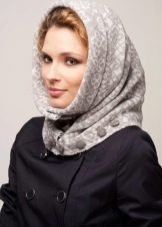
What it is?
Bonnet or cap-hood - a headdress worn during the autumn, spring, winter seasons. This garment came into fashion in the first half of the 19th century and became a seasonal alternative to the traditional bonnet. The hoods are worn on the head so that they frame the face and do not spoil the hair styled in a hairstyle. This hybrid of a cap and a woman's hat has repeatedly returned to fashion, changing its appearance in accordance with its trends.
So, the initial description indicates that he had a stiff high crown, located at the back of the head, framing the face with soft fields. Wide satin ribbons (mantonnieres) connected under the chin were used as ties. The origin of the word comes from the French "cape" or the Dutch "kaper", which also denotes the name of the headdress. Modern options do not have a rigid base, more like a stole with a fastener or a hood worn in addition to clothes without this cut detail.




History of appearance
In the era of Biedermeier (style in art), which fell on the period from 1815 to 1848, pseudo-romantic elements of the design of wardrobe items and accessories came into fashion. They were characterized by details in the spirit of the late Empire, but more delicate, light. In Russia, this period fell on Pushkin's times, when dresses with a narrow accentuated waist, puffy necklines, and bell skirts came into fashion. Bonnets, emphasizing the femininity of the exterior, became a striking detail of this style.
In the old days, bonnets were often used not only as a street piece of wardrobe. They were used to visit the temple - for weddings, funeral ceremonies, and other important events. Initially, the old style of the hood was created to be combined with hairstyles in which the bulk of the hair was at the back of the head, and the oval of the face was framed by individual curls. The high crown helped not to wrinkle the hair, the wide brim of such a cap protected it from rain, snow, and wind.




At the beginning of the 19th century, bonnets were considered exclusively an element of the wardrobe for the lower class - servants. By 1820, they were considered and loved by the mistresses of wealthy houses. Over the next 40 years, this headpiece has experienced ups and downs, and then just went out of fashion. He returned at the end of the 20th century as an element of the wardrobe of very young girls and little girls, and then of their mothers. During this period, soft knitted and fur models of caps-hoods, with a button closure and in the form of hybrids with a scarf, came into fashion.
In the 21st century, the fashion for hoods returns again, and they look truly impressive. These are luxurious fur options, voluminous snoods, softly draped cashmere and woolen headwear models. They managed to turn into a real trend, which means it's time to figure out what they are like and what these women's accessories are combined with for a cold winter.

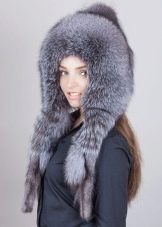


Varieties
The modern female hood looks much more varied than its prototype. It has children's versions and adults, casual and formal options. The fact that this piece of wardrobe has returned to fashion is seriously and for a long time evidenced by the fact that the authors of crossword puzzles include the question "inverted bonnet" in their creations quite regularly. There are many types and models, even men are ready to try on this version of the headdress, however, rather, in the form of a hybrid with a voluminous knitted scarf. It is worth considering all the current versions in more detail.




Ecclesiastical
Since church attendance has its own laws, all parishioners - both adults and children - have to obey them. Inside the temple, women and girls should be covered with their heads. This symbolizes humility, piety, emphasizes the importance of the sacrament being performed.... But a summer shawl for a temple is often inconvenient, and it is difficult to pick it up; instead, capes-hoods made of lightweight materials are used, covering the head and shoulders.
The color of the stole covering the head depends on the day of the visit. Easter models are red, green ones are worn on Trinity. The wedding cape for the church is made of thin, light materials in pastel shades - white, cream, pink. These colors are also suitable for everyday temple visits. The church hood has a length slightly below the shoulders, is pulled on a drawstring or tied with ribbons.
The baptismal attire is also easy to complement with an openwork or light satin cape-hood.This option is suitable for a girl from 3 to 10 years old. Standard models are used for the baptism of older children and adults. The bonnet for the godmother should not be too lavishly decorated; weddings are most often made with lace.
The winter version is made from cashmere or angora wool.




Snood hoods
This version of the men's and women's hat is a hybrid with a scarf that elegantly falls over the shoulders.... Stylish snood hoods are most often made of wool, cashmere of large or medium knitting, decorated with braids and other patterns. Effective drapery of the free part of the scarf around the neck allows you to keep warm as much as possible without losing the relevance of the image. Also, these models are made of cotton jersey, fleece, natural or artificial fur.
The main distinguishing feature of all models is the looped ends, which do not have to be hidden or draped.




With ears
A fashionable hat for a girl or a young girl - a hood with ears in the form of a cute knitted hood. Such models can have different colors, shapes, they look very original.
Choosing them as an alternative, you can maintain a stylish hairstyle, the head will not sweat and itch - this is especially important for a child.
Ears and other design elements give the product originality, harmoniously fit into the perky image of a young girl, schoolgirl or student.
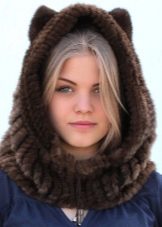



Hats
Classic hat with a high crown and soft brim - a great addition to a wedding dress in retro style. For a wedding in the spirit of the Pushkin era, such an element is perfect. The lush decoration of the bonnet with ribbons and bows, pearls, lace is suitable for the summer season. In the winter version, it is made fur, supplemented with a soft and warm sleeve for warming hands.
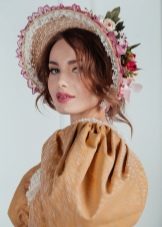
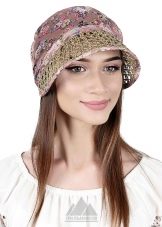
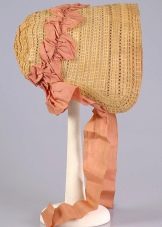

With buttons
Density adjustable hoods with buttons or small hooks are considered a versatile option for everyday wear.
This model can be easily converted from a headgear to a scarf or a hood.
Depending on the type of drapery, the fastener can be on the side or on the throat, have slit or loop loops.


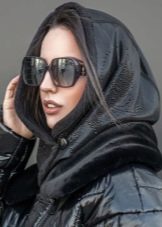

Materials (edit)
Bonnets for women and children are most often made of materials with a natural composition, soft texture. If you are allergic to wool, you can find completely acrylic models that do not cause negative reactions. Among the popular options are the following.
- Knitted hood. It is made from wool, blended yarns, or all-man-made fibers. Most often, capes-hoods made of angora and cashmere are used. Exotic versions are made from alpaca wool. They are no less warm than angora, they look attractive, very soft.
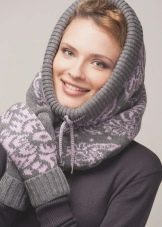

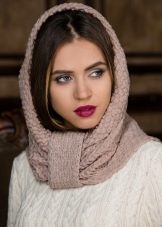
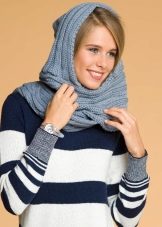
- Fleece. A popular option for men and children. It looks attractive, has an original soft texture. Such caps-hoods cover the head and shoulders, form a soft drapery, and provide good protection from the cold. Fleece is made of polyester - a strong and durable synthetic material.
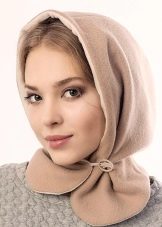



- Fur. It is used in combination with fashionable coats and sheepskin coats, fur coats. When it comes to combining with fur, it is important that it matches that used when sewing outerwear. For example, a hood and a rabbit fur coat, from a mink. Inexpensive models are made from sheepskin, nutria, fox fur.



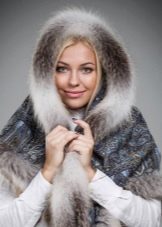
- Lace... Guipure models are used in the bride's dress, capes for church visits, baptism. Lace can be silk, cotton, blended or artificial fibers.
It is actively combined with wool and silk, fur, and is made in a double-sided version with a different design.




- Silk... Tencel is most often used here - an artificial material based on viscose. It is quite dense, used for sewing capes-hoods used when visiting the temple. Lightweight chiffon fabrics can also be used.



It will not be difficult to choose an elegant mink stole-cape or a knitted hood-snood and a lace option if you follow the rules for combining textures and shades.
Variety of colors
A fashionable hood in the 21st century looks noble and restrained. Unlike the models that were relevant in the 90s of the last century, unnaturally bright, acidic or catchy colors are not used here: crimson, blue-green, lilac.
Today it is worth choosing the current natural range - beige, brown, olive tones.
Are popular and all shades of coffee: Snood chocolate hood, cappuccino-colored fur model looks luxurious and expressive.
Fashionistas who prefer classics can limit themselves to trendy monochrome colors... Black, white, gray colors can be used alone or combined with each other. Options with contrasting braids and Scandinavian ornaments look interesting. The combination of white and red looks no less interesting.

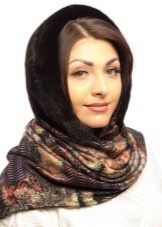


For girls with a delicate appearance and pale skin, fur hoods-capes of silver, white, cream, reddish-brown colors are well suited. In this case, the color options for silver fox or pepper and salt look exquisite. For knitted and fleece models, it is good to choose bright but noble colors: cobalt blue, gray-blue, emerald.
Owners of a bright appearance, dark skin should pay attention to wine shades - marsala, burgundy, ruby. In addition, the hood-snood will look interesting. mustard color, sand or complemented by a predatory animal print.

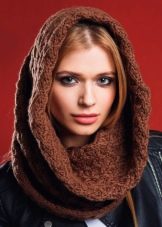


What to wear with?
Bonnets allow you to create an unlimited number of fashionable options that look bright, bold, perky, or create the image of a gentle, romantic girl. The most relevant combinations include the following.
- Bright coats and down jackets with hoods. Bright models with ears are made in a variety of color combinations. Made of fleece or knitted snoods help to create a carefree look for both adult girls and young children.




- Cashmere coat and bonnet in angora or fine cotton... It is better to choose them in a contrasting design, but in a general range of colors - pastel or natural.
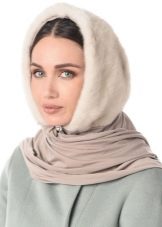



- A casual-style coat, jacket or down jacket favorably complement the chunky knit snood-hoods with a pronounced texture. They are draped effectively. The longer the scarf is, the more interesting the image will be.

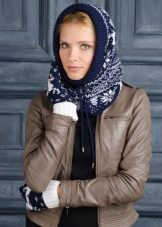

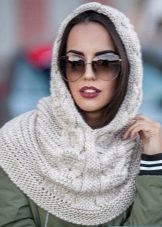
- A fur coat and a hood are combined, choosing options in one color and with one pile length. Such combinations look harmonious and are well suited for use in winter. Fur capes-hoods, knitted from braids, look interesting: they are made of mink, chinchilla. One-piece models are created from a rabbit or arctic fox.

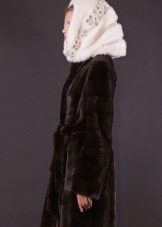


- Military style parka will complement the coarse cape-hood made of plain knit cotton jersey. The neater and simpler this wardrobe item looks, the more harmoniously it will fit into the image of a modern city woman.

By correctly combining the hood with other elements of the wardrobe, you can ensure the creation of bright, fashionable looks for every day or for special occasions.
The crochet hood pattern is shown in the following video.








